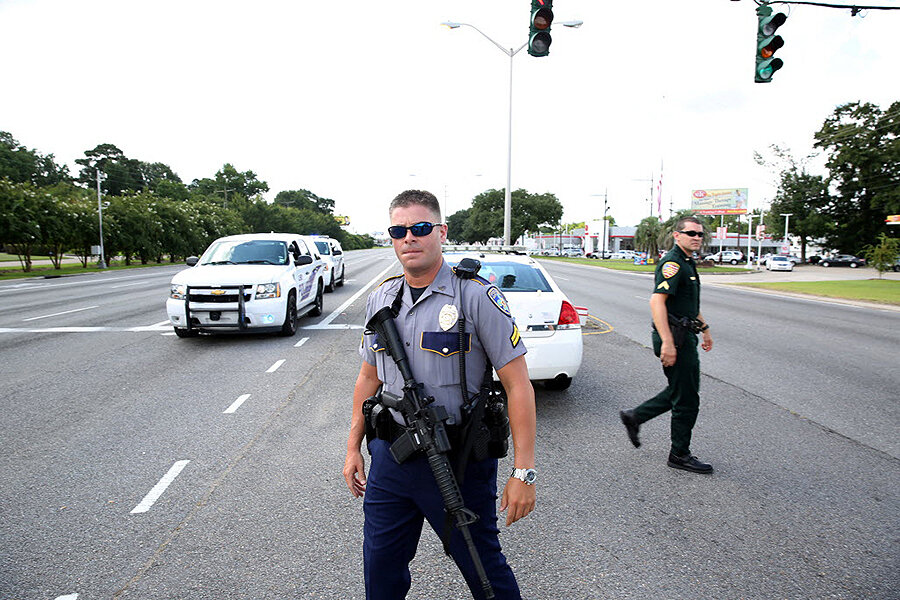Several on-duty officers shot in Baton Rouge; officials say scene is contained
Loading...
| BATON ROUGE, La.
At least several on-duty law enforcement officers were shot in Baton Rouge on Sunday morning, authorities said. The extent of their injuries was not immediately known.
The shooting – which happened just before 9 a.m., less than 1 mile from police headquarters – comes amid spiraling tensions across the city – and the country – between the black community and police. The races of the suspect or suspects and the officers were not immediately known.
Baton Rouge Police Sgt. Don Coppola told The Associated Press that he did not know the extent of the injuries or give the precise number of officers injured. He said they were rushed to a local hospital. Coppola said authorities are asking people to stay away from the area. He did not say if any of the officers had died.
Multiple police units were stationed at Our Lady of the Lake Regional Medical Center, where the stricken officers were believed to be undergoing treatment at a trauma center. A police officer with a long gun was blocking the parking lot at the emergency room.
Officers and deputies from the Baton Rouge Police Department and East Baton Rouge Sheriff's Office were involved, according to Casey Rayborn Hicks, a spokesman for the sheriff's office.
"Multiple officers from both agencies sustained injuries and were transported to local hospitals. At this point, we do not have concrete numbers or the extent of injuries. Updates will be provided as available," Casey said in a statement.
Coppola said that authorities believe the "scene is contained," meaning that a shooter was unlikely on the loose.
An Associated Press reporter on the scene saw police vehicles with lights flashing massed about a half mile from the police headquarters on Airline Highway. Police armed with long guns on the road stopped at least two vehicles driving away from the scene and checked their trunks and vehicles before allowing them to drive away.
Police-community relations in Baton Rouge have been especially tense since the killing of 37-year-old Alton Sterling, a black man killed by white officers earlier this month after a scuffle at a convenience store. The killing was captured on cellphone video and circulated widely on the internet.
Some activists hoped that officials' quick response to Mr. Sterling's death, with Louisiana Gov. John Bel Edwards calling for a Justice Department investigation one day later, signaled that "that leaders are learning from past mistakes and showing a more seasoned understanding of what it takes to rebuild lost trust and hold law enforcement accountable for its actions," as The Christian Science Monitor reported in early July:
“What it indicates is we’re in the middle of what may be a transformation in the relationship between citizens and the police department in matters of transparency and accountability,” says Jody Armour, a professor of law who specializes in criminal and racial justice at the University of Southern California.
“The governor’s proactive steps in this case may be a part of that new pattern that’s emerging in which law enforcement leaders and political leaders realize it’s more important to get in front of a story rather than play catch-up,” he says. “This suggests that a difference is being made.”
Others, however, dismissed the probes into Sterling's death as window dressing.
It was followed a day later by the shooting death of another black man in Minnesota, whose girlfriend livestreamed the aftermath of his death on Facebook. Then on Thursday, a black gunman in Dallas opened fire on police at a protest about the police shootings, killing five officers and heightening tensions even further.
Last week, three men were arrested in Baton Rouge for what authorities called a "substantial, credible threat" against law enforcement officers. In Late May, Governor Edwards signed legislation making Louisiana the first state to expand the definition of hate crimes to include violence against police.
Over the weekend, thousands of people took to the streets in Baton Rouge to condemn Sterling's death, including hundreds of demonstrators who congregated outside the police station. Authorities arrested about 200 people over the three-day weekend.
Michelle Rogers, 56, said the pastor at her church had led prayers Sunday for Sterling's family and police officers, asking members of the congregation to stand up if they knew an officer.
Rogers said an officer in the congregation hastily left the church near the end of the service, and a pastor announced that "something had happened."
"But he didn't say what. Then we started getting texts about officers down," she said.
Rogers and her husband drove near the scene, but were blocked at an intersection closed down by police.
"I can't explain what brought us here," she said. "We just said a prayer in the car for the families."







